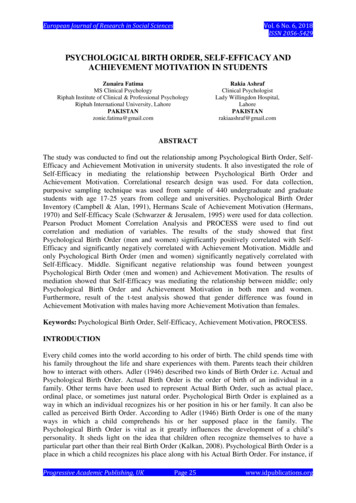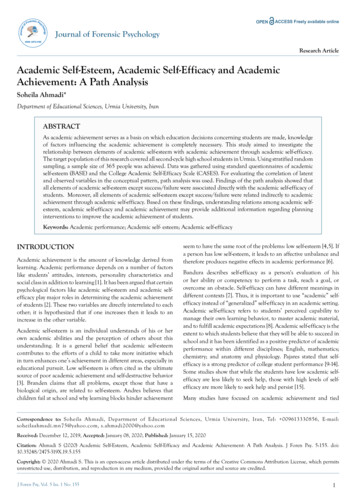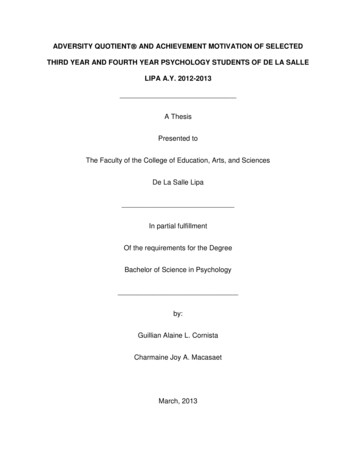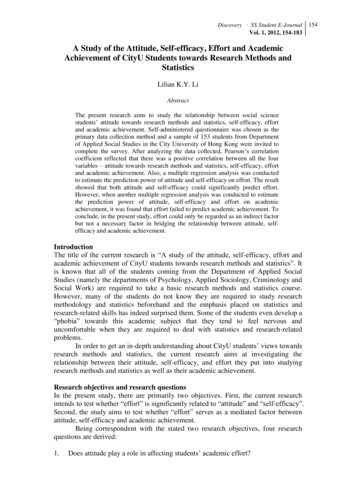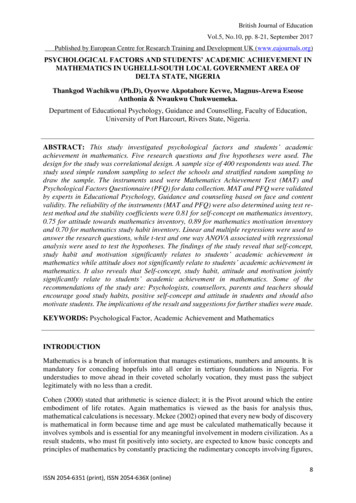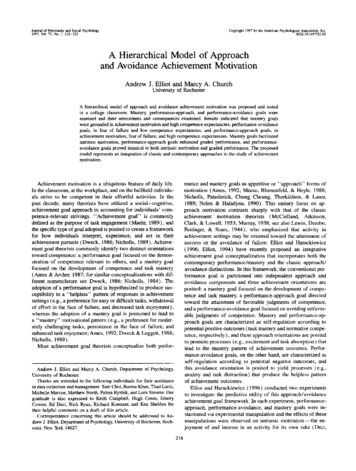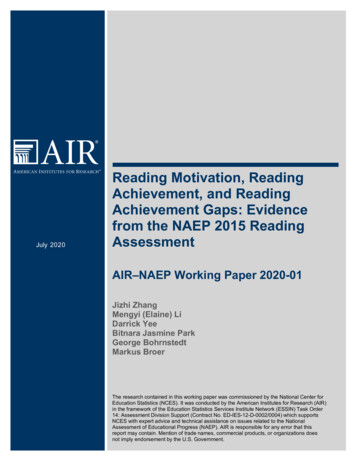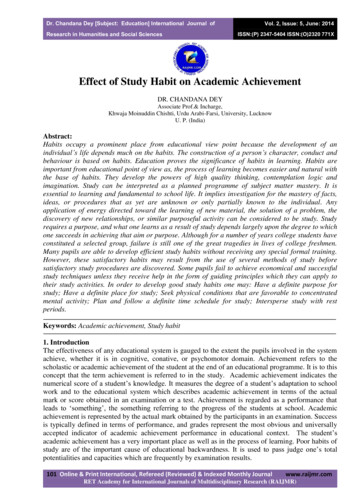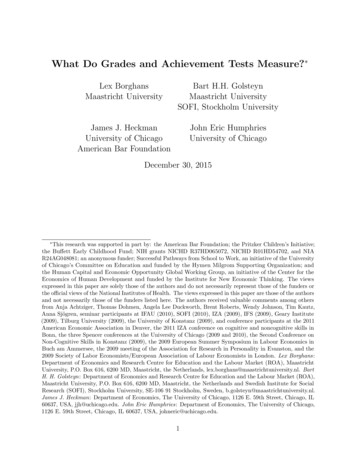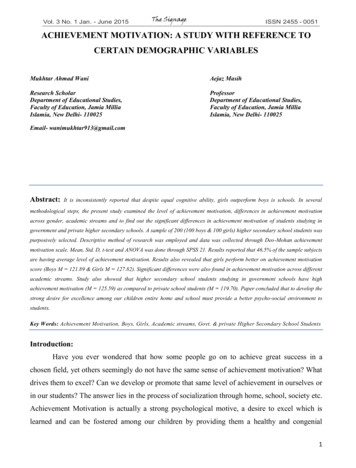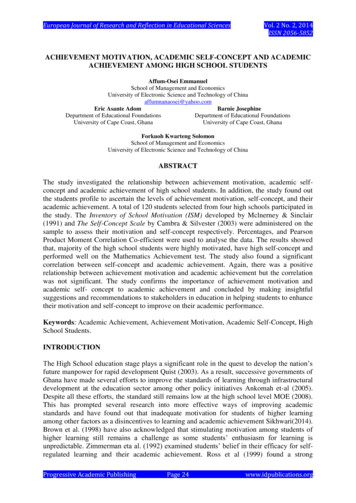
Transcription
European Journal of Research and Reflection in Educational SciencesVol. 2 No. 2, 2014ISSN 2056-5852ACHIEVEMENT MOTIVATION, ACADEMIC SELF-CONCEPT AND ACADEMICACHIEVEMENT AMONG HIGH SCHOOL STUDENTSAffum-Osei EmmanuelSchool of Management and EconomicsUniversity of Electronic Science and Technology of Chinaaffumnanaosei@yahoo.comEric Asante AdomBarnie JosephineDepartment of Educational FoundationsDepartment of Educational FoundationsUniversity of Cape Coast, GhanaUniversity of Cape Coast, GhanaForkuoh Kwarteng SolomonSchool of Management and EconomicsUniversity of Electronic Science and Technology of ChinaABSTRACTThe study investigated the relationship between achievement motivation, academic selfconcept and academic achievement of high school students. In addition, the study found outthe students profile to ascertain the levels of achievement motivation, self-concept, and theiracademic achievement. A total of 120 students selected from four high schools participated inthe study. The Inventory of School Motivation (ISM) developed by Mclnerney & Sinclair(1991) and The Self-Concept Scale by Cambra & Silvester (2003) were administered on thesample to assess their motivation and self-concept respectively. Percentages, and PearsonProduct Moment Correlation Co-efficient were used to analyse the data. The results showedthat, majority of the high school students were highly motivated, have high self-concept andperformed well on the Mathematics Achievement test. The study also found a significantcorrelation between self-concept and academic achievement. Again, there was a positiverelationship between achievement motivation and academic achievement but the correlationwas not significant. The study confirms the importance of achievement motivation andacademic self- concept to academic achievement and concluded by making insightfulsuggestions and recommendations to stakeholders in education in helping students to enhancetheir motivation and self-concept to improve on their academic performance.Keywords: Academic Achievement, Achievement Motivation, Academic Self-Concept, HighSchool Students.INTRODUCTIONThe High School education stage plays a significant role in the quest to develop the nation’sfuture manpower for rapid development Quist (2003). As a result, successive governments ofGhana have made several efforts to improve the standards of learning through infrastructuraldevelopment at the education sector among other policy initiatives Ankomah et-al (2005).Despite all these efforts, the standard still remains low at the high school level MOE (2008).This has prompted several research into more effective ways of improving academicstandards and have found out that inadequate motivation for students of higher learningamong other factors as a disincentives to learning and academic achievement Sikhwari(2014).Brown et al. (1998) have also acknowledged that stimulating motivation among students ofhigher learning still remains a challenge as some students’ enthusiasm for learning isunpredictable. Zimmerman eta al. (1992) examined students’ belief in their efficacy for selfregulated learning and their academic achievement. Ross et al (1999) found a strongProgressive Academic PublishingPage 24www.idpublications.org
European Journal of Research and Reflection in Educational SciencesVol. 2 No. 2, 2014ISSN 2056-5852relationship between stress and high school students’ performance. Research conducted byMarsh and Craven(1997) on the relationship between academic achievement and self-conceptestablished a positive correlation, therefore, it is very imperative to investigate other factorssuch as motivation and self-concept which have positive relationship with academicperformance of high school students (Achana & Chamundeswari 2013; Tella 2007; Raju2013). This study would provide necessary information for stakeholders in education toformulate policies that will aid academic performance. The study would also provideimportant suggestion to students on self-concept and motivation and also serve as a guide forfuture research by potential researchers.Objective of the StudyTo find out the level of High School Students’ Achievement MotivationTo find out the profile of High School Students’ Self-ConceptTo ascertain the Academic Achievement of High School StudentTo find out the relationship between Achievement motivation, Self-Concept andAcademic Achievement of High School Students5. To provide suggestions, recommendations and insights to students, parents, guardians,government, counsellors and other stakeholders in education.1.2.3.4.Research Questions1. What are the levels of Achievement Motivation of High School Students?2. What is the profile of High School Students’ Self-Concept?3. What is the Academic Achievement of High School Students?HypothesisH0: There is no significant relationship between High School Students’ AchievementMotivation, Self-Concept, and Academic Achievement.H1: There is significant relationship between High School Students’ AchievementMotivation, Self-Concept Academic AchievementLITERATURE REVIEWMotivationPsychologists believe that motivation is a necessary ingredient for learning (Biehler &Snowman, 1986). Satisfactory school learning is unlikely to take place in absence ofsufficient motivation to learn (Fontana 1981). Denhardt (2008), defined motivation as “whatcauses people to behave as they do” Lawler (1994) said “motivation is goal directed”.Motivation outlines the achievement and pursuit of goals (Denhardt 2008). Pettinger (1996)defined motivation as environmentally dependent. Campbell & Pritchard (1976) definedmotivation as being the set of psychological processes that cause the initiation, direction,intensity, and persistence of behavior. Denhardt, Denhardt and Aristigueta (2008) outlinedmotivation is not: directly observable, the same as satisfaction, always conscious, and directlycontrollable.Denhardt (2008) argued that motivation is not directly observable. Motivation is an internalstate that causes people to behave in a particular way to accomplish particular goals andpurposes (Denhardt, 2008). Motivation is not directly controllable: motivation is notProgressive Academic PublishingPage 25www.idpublications.org
European Journal of Research and Reflection in Educational SciencesVol. 2 No. 2, 2014ISSN 2056-5852something that people do to others and motivation occurs within people’s minds and hearts(Denhardt 2008). Motivation is not the same as satisfaction: satisfaction is past oriented,whereas motivation is future oriented (Denhardt 2008).Intrinsic, Extrinsic Motivation and AmotivationThe Self-determination theory distinguishes between different types of motivation on thedifferent reasons or goals that give rise to an action (Ryan & Deci 2000). The Selfdetermination theory distinguishes between three types of motivation, which are intrinsicmotivation, extrinsic motivation and amotivation (Ryan & Deci 2000).Intrinsic MotivationIntrinsic motivation, occurs when the activity is done out of the free choice of the individual(Ryan & Deci 2000). Intrinsically motivated behaviours are seen when there is no otherapparent reward except the activity itself (Deci 1985). Malone & Lepper (1987) definedintrinsic motivation as what people will do without external inducement. Fincham & Cain,(1986) viewed intrinsic motivation as patterns that have been associated with high perceivedability and control, realistic task analysis and planning and the belief that effort increasesone’s ability and control.Extrinsic MotivationAccording to Ryan &Deci (2000), extrinsic motivation is a construct that is relevantwhenever an activity is done in order to attain some reward. Extrinsically motivatedbehaviours are those where the controlling mechanism is easily seen (Deci 1985). Anextrinsic orientation toward learning is characterized by a concern with external reasons forworking, such as the judgment of others regarding one’s performance, grades, or someanticipated reward (Goldberg, 1994).AmotivationIn the Self-determination Theory, the researchers proposed motivation as one of theclassification of motivation. A person is amotivated, when his/her behavior lacksintentionality (Ryan &Deci, 2000). Amotivation exists in many high school students and suchstudents are not motivated in anyway.Achievement Motivation and Academic AchievementIn a research comprising several field studies and laboratory experiments, Boggiano (1992)revealed that achievement motivation positively influenced academic performance. It wasfound that motivational orientation predicted children’s standardized achievement scores(Boggiano et- al 1992). Children with an intrinsic motivation orientation had higher readingand math scores and higer overall achievement scores compared to their extrinsiccounterparts (Boggiano et-al 1992). There is a significant correlation between academicachievement and motivation (Sikwari 2014) and motivation has impact on academicachievement of secondary school students in mathematics with respect to gender (Tella2007). Highly motivated students performed better academically than lowly motivatedstudents (Tella 2007) and females are highly motivated compared to their male counterparts(Sikwari 2014). Surprisingly, a research conducted by Niebuhr (1995) to examinedProgressive Academic PublishingPage 26www.idpublications.org
European Journal of Research and Reflection in Educational SciencesVol. 2 No. 2, 2014ISSN 2056-5852relationships between several variables and students’ academic achievement, found nosignificant effect on the relationship with academic achievement. Niebuhr (1995), suggestedthat the elements of both school climate and family environment have a stronger directimpact on academic achievement.Self-ConceptAccording to Hattie (1992), Self-concept has typically been defined in terms of the cognitiveappraisal one makes of the expectations, descriptions, and prescriptions that one holds aboutone’s self. Huitt (1998) also added that, self-concept is a person’s perceptions of his or herown strengths and weaknesses. There are three aspects of self-concept which are; self-image(of what the person is), ideal self (what the person wants to be), and self-esteem (what theperson feels about the discrepancy between what she/he is and what she/he would like to be)(Lawrence1996).Self-Concept and Academic AchievementAcademic self-concept can be defined as student perception of self as learner and how she/heinteracts with the learning environment. Studies of the relationship between self-concept andachievement in educational settings have been a major focus of research and theory for manyyears (House, 1996; Hattie 1992; Hamachek, 1995; Marsh 1987). Research has supported thebelief that there is a persistent and significant relationship between self-concept and academicachievement, and the change in one seems to be associated with a change in other (Marsh1992; Marsh and Craven, 1987).However, some researchers discussed that they have not been able to resolve the issue of thecausal predominance between self-concept and academic achievement (Bryne, 1996; Hattie,1992). That is, to find out whether academic self-concept influences academic achievementor vice versa. Many self-concepts researches have reported positive self-concept to havecausal predominance over academic achievement (Shavelson & Bolus, 1982, Marsh, 1987).Marsh (1992) showed that the relationship of self-concept to school achievement is veryspecific. Better self-concept is associated with better scholastic achievement test (Raju 2013)and has a significant relationship between self-concept and academic achievement (Sikhwara2014; Archana & Chamudeswari 2013). Teachers must consider students’ self-concept on aspecific subject as an important factor for students’ achievement (Koutsoulis 1995) becausestudents who have good self-concept of themselves is performing well to please themselves,their parents and to get admission into higher institutions of their choice (Raju, 2013).However, other researchers hold opposing views and their investigation have supported theview that academic achievement precedes a positive self-concept (Bachman & O’ Mally,1986). A research conducted on the effect of students’ self-concept and gender on academicachievement in science by Rana &Iqbal (2005); showed that, the interaction between thestudents’ gender and self-concept has significant effect on the science achievement ofstudents in grades 11 and 12. Olantunde (2010) showed in a research conducted on students’self-concept and Mathematics achievement that, students who have positive self-concept ofthemselves performed well in mathematics.Progressive Academic PublishingPage 27www.idpublications.org
European Journal of Research and Reflection in Educational SciencesVol. 2 No. 2, 2014ISSN 2056-5852METHODOLOGYResearch DesignThe research was a descriptive survey. Descriptive research is a procedure for organizing andsummarizing data in order to communicate and describe important characteristics of the data,it determines and reports the way things are (Gay, 1996). According to Gay (1996), adescriptive survey method is useful for investigating a variety of educational problemsincluding assessment of attitudes, opinions, demographic information, conditions andprocedures.PopulationThe population for the study comprised all Senior High School forms 1, 2, and 3 Students inthe Western Region of Ghana. Four schools were selected from the Schools in the Region.Two schools were selected from urban area and two from the rural area.Sample and Sampling ProceduresThe Senior High Schools of Western Region were listed and grouped into urban school andrural school and two schools were randomly selected from each category. The samples for thestudy were selected using the stratified random sampling technique. In all, four Senior HighSchools were sampled. One hundred and twenty (120) students were selected from fourschools. A total of 30 students were sampled from each selected senior high school.Research InstrumentThe researchers adopted questionnaire as an instrument for the study. The research soughtinformation on demographic issues of the respondents. Students responded to likert scale typeof items selected from The Self-Concept Scale by Cambra & Silvestre (2003) where studentswere rated from “strongly disagree” to “strongly agree”. The self- concept instrument used inthis study was originally developed by Cambra and Silvestre (2003). The adapted scaleconsists of 23 items (Yes /No), which are connected to three dimensions of self-concept(academic, social and physical). The instrument was given to two test-items analysts in orderto establish its face and content validity. Over previous studies, the original scale Cronbach’scoefficient alpha was 0.81 and 0.75. The reliability of the original scale is ascertained with aCronbach’s coefficient alpha of 0.73. Another part of the instrument elicited students’response on achievement motivation. The students answered likert scale type of items. It ismade up of twelve items selected from The Inventory of School Motivation (ISM) byMclnerney &Sinclair (1991). The original instrument consist of 34 items measured on a 5point Likert scale (1 Strongly Disagree to 5 Strongly Agree). Finally, students respondedto mathematics achievement test. It consists of 30 multiple choice questions selected frompast questions of the West African Examination Council (W.A.E.C). The WAEC is a bodythat organizes final examinations for high school students and the mathematics achievementtest was adopted from one of its past questions administered in 2000.Data AnalysisThe completed questionnaires were serially numbered for easy identification and were finallyscored. Items on the four point likert scale was scored 1, 2, 3, and 4 for items with theresponse strongly disagree, disagree, agree and strongly agree respectively.Progressive Academic PublishingPage 28www.idpublications.org
European Journal of Research and Reflection in Educational SciencesVol. 2 No. 2, 2014ISSN 2056-5852Percentages and the Pearson Product Moment Correlation Coefficient were used for theanalysis. The range, mean, and the standard deviation were used to classify achievementmotivation, academic self-concept, and academic achievement. The Pearson Product MomentCorrelation was used to describe the relationship between academic self-concept,achievement motivation and Academic Achievement.RESULTSThe Profile of Senior High Schools Students’Table 1: Sex of the RespondentsRespondentsMalesFemalesTotalSource: Field DataFrequency (N)7842120Percentage (%)6535100Table 1 shows that out of the sample of 120 respondents, there were 78 (65%) males and 42(32%) females.Table 2: Age range of respondentsAge Range12-1415-1718-20OthersTotalSource: Field DataFrequency (N)232778120Percentages (%)1.726.964.76.7100Table 2 shows the age range of the respondents. Out of the 4 categories given, 2 (1.7%) fallwithin the age range of 12-14, 32 (26.9%) were within the age range of 15-17, 77 (64.7%)were within the age range of 18-20, 8 (6.7%) represent those who did not fall within the agerange given.Table 3: Forms of the respondentsFormsOneTwoThreeTotalFrequency (N)404040120Percentages (%)33.333.333.3100Source: Field DataTable 3 shows the forms of the respondents. Forty (40) students representing 33.3%responded to the questionnaire in each form from the four schools. This shows that thequestionnaire was distributed fairly to the students in their various forms or classes.Table 4: Courses of Study of the Sampled StudentsCoursesGeneral ArtsHome EconomicsBusinessVisual ArtsAgricultural ScienceScienceOthersTotalSource: Field DataFrequency (N)32510135611120Progressive Academic PublishingPercentages (%)26.74.28.30.82.546.79.2100Page 29www.idpublications.org
European Journal of Research and Reflection in Educational SciencesVol. 2 No. 2, 2014ISSN 2056-5852Table 4 shows the course of study of the respondents. There were 32 (26.7 %)General Arts students, 5 (4.2%) students in Home economics class, 10 (8.3%) Business and 1(0.8%) was a Visual Arts student who responded to the questionnaire. There were 3 (2.5%)students who were reading Agric. Science, 56 (46.7%) were Science students and 11 (9.2%)were reading other courses. It must also be stated that, majority of the students read Science.Research Question 1What are the levels of High School Students’ Achievement Motivation? This researchquestion sought to find out the level of achievement motivation of senior high schoolstudents.Table 5: Senior High School Students’ Achievement MotivationVariablesSex: Male:Female:TotalAge: 12-1415-1718-20OthersTotalForm: oneTwoThreeTotalCourse: General ArtsHome Econs.BusinessVisual ArtsAgric ScienceScienceOthersTotalSource: Field DataLowN (%)7 (9.0)5 (11.9)12 (10)0 (0)3 (9.4)6 (7.8)3 (37.5)12 (10.1)4 (10)3 (7.5)5 (12.5)12 (10.0)4 (12.5)0 (0)1 (10)0 (0)0 (0)4 (7.1)3 (27.3)12 (10.2)HighN (%)71 (91)37 (88.1)108 (90)2 (100)29 (90.6)71 (92.2)5 (62.5)107 (89.9)36 (90)37 (92)35 (87.5)108 (90.0)28 (87.5)5 (100)9 (90)1 (100)3 (100)52 (92.9)8 (72.7)106 (89.8)TotalN (%)78 (100)42 (100)120 (100)2 (100)32 (100)77(100)8 (100)119 (100)40 (100)40 (100)40 (100)120 (100)32 (100)5 (100)10 (100)1 (100)3 (100)56 (100)11 (100)118 (100)Table 5 shows the level of motivation of the high school students. Out of 120 students, 12(10%) had low motivation and 108 (90%) had high motivation. These findings show thatmajority of the students were highly motivated. Out of a total of 78 males, 7 (9.0%) had lowmotivation and 71 (91.0%) were highly motivated. Out of a total of 42 females, 5 (11.9%)had low motivation and 37 (88.1%) were highly motivated. Students within the age range of12-14 years were 2 (100%) and they were highly motivated. Students within the age range of15-17 years were 32 of which 3 (9.4%) had low motivation and 29 (90.6%) had highmotivation. Students within the age range of 18-20 years were 77 out of which 6 (7.8%) hadlow motivation and 71 (92.2%) were highly motivated. Other age range was 8 and 3 (37.5%)had low motivation and 5 (62.5%) were highly motivated. Form one students were 40, out ofthese, 4 (10%) had low motivation and 36 (90%) had high motivation. Form two studentswere 40, of which 3 (7.5%) had low motivation and 37 (92.5%) had high motivation. Formthree were also 40 students of which 5 (12.5%) had low motivation and 35 (87.5%) werehighly motivated. General Arts students were 32 and of these 4 (12.5%) recorded lowmotivation while 28 (87.5%) were highly motivated. There were 5 Home Econs. Studentsand all were highly motivated. Out of 10 Business students, 1 (10%) had low motivation andProgressive Academic PublishingPage 30www.idpublications.org
European Journal of Research and Reflection in Educational SciencesVol. 2 No. 2, 2014ISSN 2056-58529 (90%) had high motivation. Visual Arts student was 1 (100%) and was highly motivated.There were 3 (100%) Agric Science students and they were all highly motivated. Out of 56Science students 4 (7.1%) had low motivation and 52 (92.9%) were highly motivated. Otherstudents who were reading other courses were 11 of which 3 (27.3%) had low motivation and8 (72.7%) were highly motivated.Research Question 2What is the Profile of Students’ Self-concept? This research question sought to find out theprofile of self-concept of high school students. The second part of the questionnaire elicitedparticipants’ responses.Table 6: Profile of Senior High School Students’ Self-ConceptVariableSex: Male:Female:TotalAge: 12-1415-1718-20OthersTotalForm: oneTwoThreeTotalCourse: General ArtsHome Econs.BusinessVisual ArtsAgric ScienceScienceOthersTotalSource: Field DataLowN (%)3 (3.8)5 (11.9)8 (6.7)1 (50)5 (15.6)1 (1.3)0 (0.0)7 (5.9)3 (7.5)3 (7.5)2 (5.0)8 (6.7)3 (9.4)1 (20)1 (10)0 (0)0 (0)2 (3.6)0 (0)7 (5.9)HighN (%)75 (96.2)37 (88.1)112 (93.3)1(50)27 (84.4)76 (98.7)8 (100)112(94.1)37 (92.5)37 (92.5)38 (95.0)112 (93.3)29 (90.6)4 (80)9 (90)1 (100)3 (100)54 (96.4)11(100)111 (94.1)TotalN (%)78 (100)42 (100)120 (100)2 (100)32 (100)77 (100)8 (100)119 (100)40 (100)40 (100)40 (100)120 (100)32 (100)5 (100)10 (100)1 (100)3 (100)58 (100)11(100)118 (100)Table 6 shows the profile of high school students’ Self-Concept. Out of a total of 120students, 8 (6.7%) had low self-concept and 112 (93.3%) had high self-concept. This showsthat majority of the students had high self-concept. From a total of 78 (65%) males, 3 (3.8%)recorded low self-concept and 75 (96.2%) had high self-concept. There were 42 (35%)females of which 5 (11.9%) had low self-concept and 37 (88.1%) had high self-concept. Thisshows that, majority of male students have recorded high self-concept compared to femalestudents.The ages ranging from 12-14 were 2 students and 1 (50%) had low self-concept while 1(50%) had high self-concept. There were 32 within 15-17 years, of these 5 (15.6%) had lowself-concept and 27 (84.4%) had high self-concept. There were 77 students within the ages of18-20, out of which 1 (1.3%) had low self-concept and 76 (98.7%) had high self-concept.Other ages which did not fall within the age groups were 8, of which none had low selfconcept and all the 8 (100%) had high self-concept.Progressive Academic PublishingPage 31www.idpublications.org
European Journal of Research and Reflection in Educational SciencesVol. 2 No. 2, 2014ISSN 2056-5852Form one students were 40 of which 3 (7.5%) had low self-concept and 37 (92.5%) recordedhigh self-concept. Form two students were 40 and out of these 3 (7.5%) had low self-conceptand 37 (92.5%) recorded high self-concept. Form three students were 40, 2 (5.0%) had lowself-concept and 38 (95%) had high self-concept. The data show that, form three studentsrecorded the highest self-concept followed by form one and two students. There were 32students who read General Arts, out of these 3 (9.4%) had low self-concept and 29 (90.6%)had high self-concept. Home Econs. were 5, 1 (20%) had low self- concept and 4 (80%) hadhigh self-concept. Business students were 10 and 1 (10%) had low self-concept and 9 (90%)had high self-concept. Only 1 (100%) student read Visual Arts and the student recorded highself-concept. In Agric Science, there were 3 students and all had high self-concept. Therewere56 Science students of which 2 (3.6%) had low self-concept and 54 (96.4%) had high selfconcept. Other students offering other courses were 11 all of which had high self-concept.Research Question 3What is the Academic performance ofHigh School Students? The students answered standardmultiple choice mathematics achievement test to ascertain the level of academic performance.Table 7: Academic Performance of Senior High School StudentsVariableSex: Male:Female:TotalAge: 12-1415-1718-20OthersTotalForm: oneTwoThreeTotalSource: Field DataBelow AverageN (%)15 (19.2)25 (59.5)40 (33.3)1 (50)15 (46.9)20 (26)3 (37.5)39 (32.8)19 (47.5)10 (25)11 (27.5)40 (33.3)Average Above AverageN (%)N (%)29 (37.2)34 (43.6)16 (38.1)1 (2.4)45 (37.5)35 (29.2)0 (0.0)1 (50)14 (43.8)3 (9.4)27 (35.0)30 (39.0)4 (50)1 (12.5)45 (37.8)35 (29.4)12 (30)9 (22.5)17 (42.5)13 (32.5)16 (40)13(32.5)45 (37.5)35 (29.2)TotalN (%)78 (100)42 (100)120 (100)2 (100)32 (100)77 (100)8 (100)119 (100)40 (100)40 (100)40 (100)120 (100)Table 7 shows the academic performance of the students. Out of a total of 78 males 15(19.2%) were below average and 29 (37.2%) were average while 34 (43.6%) were aboveaverage. Out of a total of 42 female students 25 (59.2%) scored below average, 16 (38.1%)were average and 1 (2.4%) was above average.Students within the age range of 12-14 years were 2, out of which 1 (50%) was belowaverage and 1 (50%) scored above average. Students within the age range of 15-17 yearswere 32, out of which 15 (46.9%) scored below average, 14 (43.8%) of these students scoredaverage and 3 (9.4%) scored above average. A total of 77 were in the 18-20 years group, outof which 20 (26.0%) were below average, 27 (35.0%) were average students and 30 (39.0%)were above average. There were 8 students who did not fall within the age categoriesprovided on the questionnaire, out of these, 3 (37.5%) were below average and 4 (50%) wereaverage students while 1 (12.5%) was above average. Out of 40 students in form one, 19(47.5%) were below average, 12 (30.0%) were average students and 9 (22.5%) scored aboveaverage. Out of 40 form two students, 10 (25%) were below average, 17 (42.5%) wereProgressive Academic PublishingPage 32www.idpublications.org
European Journal of Research and Reflection in Educational SciencesVol. 2 No. 2, 2014ISSN 2056-5852average and 13 (32.5%) were above average. Out of 40 form three students, 11 (27.5%) werebelow average, 16 (40%) were average students and 13 (32.5%) were above average.HypothesisSpecifically, the study provided answer to one research hypothesis. Table 7 shows the resultsin accordance to the research hypothesis. In this study, one null hypothesis was tested for thesignificant level at 0.01.H0: µ1 µ2. There is no significant relationship between Senior High School Students’Achievement Motivation, Academic Self-Concept, and Academic AchievementH1: µ1 µ2. There is a significant relationship between Senior High School students’Achievement Motivation, Academic Self-Concept, and Academic Achievement.Decision Rule:Reject H0 but accept H1, if calculated p 0.01Accept H0, but reject H1, if calculate p 0.01** Given a significant level of 0.01 (2 tailed), when p is less than 0.01 there is a significantrelationship.The results of the above hypothesis are presented in Table 7.Table 8 Correlation Matrix for Self-Concept, Motivation and Academic AchievementVariablesSelf-ConeptAchiev. MotivationSelf-concept1Achiev. Motivation.151Academic Achiev.72(**).03**correlation is significant at the 0.01 level (2-tailed)Achiev. in Mathematics1Table 8 shows the correlation between self-concept, achievement motivation and academicachievement. The result clearly reveals that a very strong significant relation exists betweenstudents’ self-concept and academic achievement (r .72, p 0.01). This means that asstudents’ self-concept increases the academic achievement also increases. The result alsoclearly reveals that, there is no significant relationship between students’ achievementmotivation and academic performance (r .03, p 0.01). This indicates that, relationshipexists but not significant to have any significant impact on students’ performance. Again,there is no significant correlation between self-concept and achievement motivation (r .15,p 0.01). This means that, there is an existed relationship between self-concept andachievement motivation but the relationship is not significant.DISCUSSIONThe first research question sought to find out the level of motivation of high school students.The results showed that, 71 (91%) male students were highly motivated as compared to 5(11.9%) female students who had low motivation. This result shows that male students werehighly motivated. The result contrasted with the research result of Sikhwari (2014), whofound that, female high school students were highly motivated compared to their malecounterparts. This contrasted result may be due to environmental differences. In Ghanamotivation of females to study mathematics related courses is low.The second research question gathered the profile of students’ self-concept. The resultsindicated that 75 (92.2%) males have higher self-concept compared to 37 (88.1%) females.This finding is consistent with a research conducted by Rana & Iqbal (2005), there is aProgressive Academic PublishingPage 33www.idpublications.org
European Journal of Research and Reflection in Educational SciencesVol. 2 No. 2, 2014ISSN 2056-5852significant cause-effective relationship between students’ self-concept and gender and thatmales have higher self-concept compared to females.Form three students had the highest self-concept and form one and form two students had thelowest self-concept
achievement in science by Rana &Iqbal (2005); showed that, the interaction between the students' gender and self-concept has significant effect on the science achievement of students in grades 11 and 12. Olantunde (2010) showed in a research conducted on students' self-concept and Mathematics achievement that, students who have positive .
